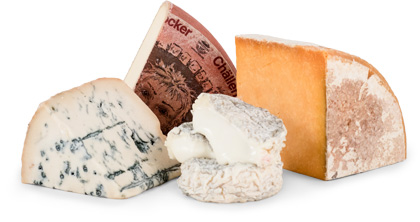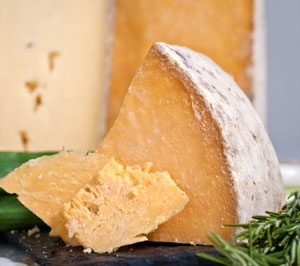Manchego derives its name from the central region of La Mancha, which was also the home of the legendary Don Quixote. It is to Spain what cheddar is to England: a legend in its own land and a treasure for the rest of the world. This month, it is a special privilege to present this tasty, piquant and nutty ewe’s milk cheese to our loyal club members. It’s a cheese with a rich history as unique as is its pleasing taste.
Not surprisingly, Spain's most famous cheese enjoys not only a rich taste, but a rich history that can be traced back to ancient times. The La Mancha plains in southern and central Spain were a focus of dispute for centuries between Northern Christians and Southern Muslims who fought for control of its pastures. Historians of early Rome chronicled the area for its livestock farming. The Muslims that inhabited the land from the 8th through the 11th centuries dubbed it "Manya," which means "land without water." Eventually, that would translate into "Mancha," the name that is used today.
In the 12th century King Alfonso VI conquered and united the region forcing the Muslim inhabitants to retreat to the Andalucia region of modern day Spain. By the end of the century, the resulting lack of political stability led the area's stock farmers to organize cooperatives, which in turn helped bring stronger identity and political and economic power to the region's agricultural inhabitants. By the 1600s, farming had advanced, but more efficient use of pastureland led to the decline of stock-farming and the rise of land farming. By the mid-1800s, wool production (once a staple of the region) was in decline and the production of meat and cheese moved to the forefront of the local economy.
By the beginning of the 1900s cheese production steadily grew and La Mancha evolved into a regional cheese powerhouse with production techniques tied to the local Manchega sheep herds. The result is the delicious and unique cheese that is being made available to you today.
True Manchego is produced only from the milk of the Manchega sheep. (Other Spanish cheeses made with ewe’s milk are commonly referred to as Manchego-style.) The Manchega sheep graze mostly on dry pasture, fallow land and stubbly brush fields on a high plateau outside of the cities of Toledo, Albacete, and Cuenca in a region southeast of Madrid. The somewhat harsh grazing conditions in the region might be expected to yield low-fat milk from which the cheese is manufactured. In fact, the opposite is true. Manchego actually has a fat content of up to 57 percent, which explains its rich, intoxicating taste that is savored throughout the world.
The base milk used for the cheese must have at least 6 percent fat. The cheese is subjected to a rigorous and detailed production process while subjected to levels of 75 to 85 percent humidity. Typically Manchego is produced in a cylindrical shape with each cheese weighing between four and eight pounds.
Manchego has a distinctive flavor and an equally distinctive look. It can be recognized by a unique zigzag or cross hatch pattern on its black-gray or buff-colored rind which is created by the rippled surface of the press used to make it. Don’t eat the rind—it’s inedible— but inside you’ll discover an ivory-colored interior with several small holes that’s a real treat. Most cheese lovers are pleasantly surprised at their first taste of this hard cheese. It has an intense, zesty taste and a crumbly texture that's rich, full and slightly salty at the finish. Even its aroma has been described as special, suggesting roast lamb to some. Manchego is marketed at various stages of maturity from "cured" at 13 weeks to "aged" at more than three months. The aging period must be a minimum of 60 days. Due to its rich flavor, serve solo as a snack, pair it with bread, or serve with fruit for dessert.

Experience International Variety
You might receive a Gaperon, originating in France during the 14th Century, an
authentic Lancashire by Ruth Kirkham, and an Italian Taleggio matured in the
caves of Valsassina…all in one shipment!


